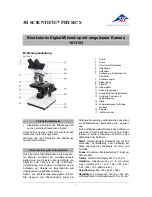
7
Any reference to the PSF in the following discus-
sion exclusively refers to the half-maximum area.
Quantitatively the half-maximum area is described
in terms of the full width at half maximum
(FWHM), a lateral or axial distance corresponding
to a 50% drop in intensity.
The total PSF (PSF
tot
) of a confocal microscope
behind the pinhole is composed of the PSFs of the
illuminating beam path (PSF
ill
; point illumination)
and the detection beam path (PSF
det
; point detec-
tion). Accordingly, the confocal LSM system as a
whole generates two point images: one by pro-
jecting a point light source into the object space,
the other by projecting a point detail of the object
into the image space. Mathematically, this rela-
tionship can be described as follows:
PSF
ill
corresponds to the light distribution of the
laser spot that scans the object. Its size is mainly a
function of the laser wavelength and the numeri-
cal aperture of the microscope objective. It is also
influenced by diffraction at the objective pupil (as
a function of pupil illumination) and the aberra-
tions of all optical components integrated in the
system. [Note: In general, these aberrations are
low, having been minimized during system
design].
Moreover, PSF
ill
may get deformed if the
laser focus enters thick and light-scattering
specimens, especially if the refractive indices
of immersion liquid and mounting medium are
not matched and/or if the laser focus is at
a great depth below the specimen surface
(see Hell, S., et al., [9]).
PSF
det
is also influenced by all these factors and,
additionally, by the pinhole size. For reasons of
beam path efficiency (see Part 2), the pinhole is
never truly a point of infinitely small size and thus
PSF
det
is never smaller in dimension than PSF
ill
. It is
evident that the imaging properties of a confocal
LSM are determined by the interaction between
PSF
ill
and PSF
det
. As a consequence of the interac-
tion process, PSF
tot
≤
PSF
ill
.
With the pinhole diameter being variable, the
effects obtained with small and big pinhole diam-
eters must be expected to differ.
In the following sections, various system states are
treated in quantitative terms.
From the explanations made so far, it can also be
derived that the optical slice is not a sharply delim-
ited body. It does not start abruptly at a certain Z
position, nor does it end abruptly at another.
Because of the intensity distribution along the
optical axis, there is a continuous transition from
object information suppressed and such made
visible.
Accordingly, the out-of-focus object information
actually suppressed by the pinhole also depends
on the correct setting of the image processing
parameters (PMT high voltage, contrast setting).
Signal overdrive or excessive offset should be
avoided.
Optical Image Formation
Part 1
PSF
tot
(x,y,z) = PSF
ill
(x,y,z)
.
PSF
det
(x,y,z)
(1)
337_Zeiss_Grundlagen_e 25.09.2003 16:16 Uhr Seite 10









































